Fall Chores: It’s Time to Get Started
Posted on Tuesday, October 12, 2021 · Leave a Comment
Those big yellow school buses have been lumbering along for well over a month now, so you know it is time to start getting your gardens ready for winter. This is a good time to work outside: the bugs are fewer and it’s not so cold that you’ll be miserable in an hour.
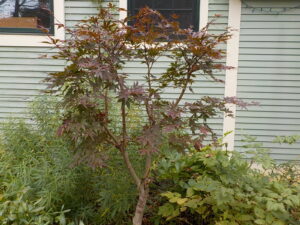
This Japanese red maple was full of clutter before pruning
I recently did some pruning on my Japanese red maple (Acer palmatum) trees. We all know that sugar maples pump sweet sap up from the ground in spring, but did you know that all maples send lots of liquid up in spring, even if not the sweet stuff? Because of that, spring is not a good time to prune. Now is a much better time.
I attended a pruning workshop in 2019 at Shin Boku Nursery in Wentworth, NH. Palmer Koelb has been growing, pruning and selling trees trained in the Japanese tradition for over 50 years. Some of his nursery stock is several decades old, and all of it is beautiful.
One of the things I learned at that workshop is that Japanese red maples are best trained over time. It is better to do a little pruning every year or two than to wait 10 years and need to cut big branches. I was told that I should never use a saw on a Japanese red maple, apparently they don’t react well to removing big branches. Hand pruners are best.
So what did I do? I reigned in the height of my trees. I like them to top out at around eight feet, so I looked for skyward-growing branches and cut each back to a lower fork, one hidden in the foliage. I also removed extraneous foliage and small branches in the interior of the trees, opening up the center of the tree so that the interesting branch shapes are visible. These trees, by their very nature, are not dominated by a single straight trunk, and I want to see the structure of a tree. I remove clutter, and rubbing branches.
This also a good time to shape all your hydrangeas, and prune them to keep them to the size you like. If you want to develop a new hydrangea to be upright, this is a good time to prune out downward-growing branches, and even to stake up a central branch to be the “leader” growing upwards.
I like to collect some flowers for drying indoors. Most of us cannot afford to buy flowers from a florist for the table each week, so picking blossoms now that look good in a dry vase is a good alternative. All the hydrangeas will provide lovely blossoms now, so long as you pick them before frost, which causes them to turn brown.
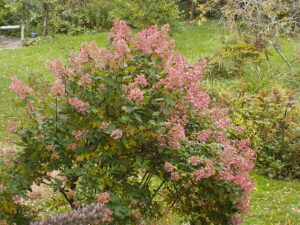
‘Pink Diamond’ hydrangea blooms each year in the fall.
My favorite hydrangea is one called ‘Pink Diamond’. It produces lots of big pointy flower panicles that start our white and turn to pink. In a dry vase the pink will fade a little, but stay quite pink all winter, as will other hydrangeas. The stems on Pink Diamond are stiff and upright on the bush and don’t flop the way some others like ‘Annabelle’ do when rained on.
Unlike lilacs and forsythia, hydrangeas are late-season bloomers so you do not lose any blossoms next year if you prune now. They bloom on stems that grow in the spring. I like to leave some blossoms on all winter to remind me that summer will get here eventually.
Grasses and grains are blooming now, and can look good in a dry vase, too. I grew an annual grain this year called black millet and I recently picked some stems and put them in a dry vase. Millet produces small seeds on narrow “cobs” much like corn, but without the outer leaves. It is found in bird seed mixes, and I ate it as a gruel when serving in the Peace Corps in West Africa. This year I bought some plants at a nursery, but will start plenty from seed next year. ‘Purple Majesty’ is probably the name of the variety I planted.
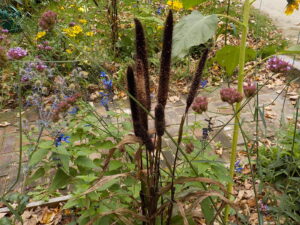
Black millet works well in a dry vase
I’ve been potting up annual plants I want to bring in before winter, rather than waiting until the afternoon before the first hard frost. I potted up some ‘Diamond Frost’ Euphorbia that I bought in small pots last spring and planted in the ground. This is a delightful plant that has tiny white blossoms all summer. As a “Proven Winner” plant, it is trademarked and is not sold by seed.
Diamond Frost makes a nice house plant that continues to bloom indoors all winter. It prefers a bright window sill, but will survive most anywhere so long as you remember to water it regularly. Then in the spring it can go outdoors again – and at no expense.
Each fall I dig up at least one rosemary plant and bring it indoors. I like to do this early in the fall so that it can get used to being in a pot while sitting in the garden in just the same place it was in the ground. This lets it have fewer changes in its environment at a time. Later I will wash it well with a hose in order to get off any aphids or other pests before bring it indoors.
Don’t use any fertilizer now for any houseplants coming inside. A plastic pot or an enameled one will keep moisture in better than an unglazed clay pot, if you are a lazy waterer, select them.
Raking the leaves can wait till later, after all the leaves have fallen. But go outside and start chipping away at the chores on nice days, even if it means playing hooky from work.
Henry is the author of 4
gardening books. Reach him at
henry.homeyer@comcast.net or by mail at PO Box 364, Cornish Flat, NH 03746.
Arrangements for Early Spring
Posted on Sunday, May 23, 2021 · Leave a Comment
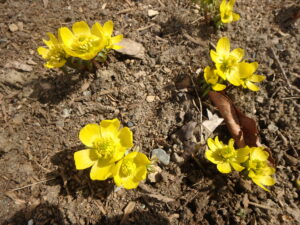
Winter aconite blooms about the same time as snow drops
I miss being able to go to my garden and pick flowers for the table. Yes, spring is on the way and even feels present on good days now. But it will be awhile until my daffodils and tulips bloom. My winter aconite, small yellow bulb flowers, are blooming, and little white snowdrops have pushed through frozen earth. Those mini-flowers aren’t really suitable for a bouquet, but I’ve picked a few things that please me.
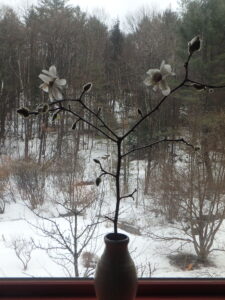
Forced flowers of my Merrill magnolia took 6 weeks to bloom
First, I picked some stems from my ‘Merrill’ magnolia. It is loaded with fuzzy buds for its late-April blooming, and these look good in an arrangement. Magnolia branches tend to fork and grow in different directions, so placing stems in a vase can be tricky. I put some in a dry vase with dried flowers and seed-bearing stems and one in a vase with water to put on a windowsill. The buds I picked on January 31 bloomed on March 17.
Beech branches are good for arrangements, too. The young trees, anyway, hold onto their light brown leaves, filling spaces in a vase. And the stems are a smooth gray, with cigar-shaped, pointy buds.
Of course red- or yellow-twigged dogwood stems add color to a winter arrangement. Each year one must cut back the plants in spring or winter to get the color on the new stems. They are fast-growing plants, so they can grow 5 feet of new stem in a single summer. They grow best in moist or marshy places.
For contrast in my vase I like to have some dark stems. Trees in the cherry family ( Prunus spp.) do well there. Chokecherry, pin cherry and black cherry look good in a vase. Young white birch have dark stems, as does hop hornbeam. But basically, you can pick any tree branches if you like their look.
Greenery is nice for contrast with bare stems. I recommend white pine for greenery. I has a nice weeping tendency, and is great around the outside of the vase. Unlike Canadian hemlock, it holds onto it needles quite well, but hemlocks are more common on my property, so I often use them.

A dry vase with Pink Diamond hydrangea, teasel, beech, and magnolia stems
Then there are the hydrangeas. Many species and varieties hold onto their flower panicles well into winter and can be quite nice in a vase. My favorite is one called ‘Pink Diamond’. It has long stems and it holds onto the fertile and infertile inflorescences, showing contrast between white and black florets on the panicles. Although the blossoms are pink toward the end of their bloom cycle, they are not pink after frost.
Winter weeds can be interesting, too. One of my favorites for winter picking is teasel. Technically, this is a biennial weed. I harvested some seeds from a corn field in Ohio years ago. The corn farmer thought I was a total nut case because to him, teasel is a noxious weed. But I have learned its habits and allow just half a dozen plants to flower and produce seed every year, and it is a delightful addition to winter arrangements.
The key to keeping teasel in check is to recognize the first year plants. They are rosettes of light green leaves. I pull most, but leave half a dozen to mature and bloom in year two. The second year plants are loaded with thorns, and have a deep tap root, so if you pull them then, you must wear gloves. I rub the thorns off while wearing gloves as I pick them, and can then handle them with ease when arranging them in a vase.
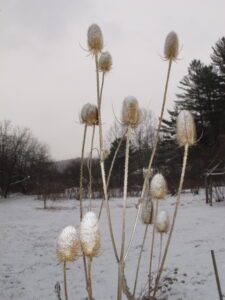
Teasel stands out nicely in winter, both in the garden and in a vase
Astilbes bloom magnificently for me, and their winter stems are great in a dry vase. I have many different species and varieties ranging from short (12-inch blossom stems) to tall (48-inches). Their chief requirement is moist soil, and I have plenty of that. If you don’t have moist soil, the leaves will brown up in the heat of summer. One trick I have tried in dry locations is to bury a plastic bag a foot or so deep in the soil before planting. That will act like a little bathtub and hold some water in dry times. They like a half day of sunshine, and prefer morning sun.
Snake root or black cohosh (formerly called Cimicifuga spp. Now in the genus Actea) holds on to dry blossoms long after summer has passed. They look good in dry arrangements if you have any still standing.
Winter arrangements tend to be fairly monochromatic – tan or brown colors are most common. I have seen gardeners use dry allium (onion-family) blossoms to bring color to the table by spray painting them with red, blue, purple and yellow spray paints. I have never done so, but if I think to harvest some next spring or summer, I may do so. I have even seen them sprayed while still in the garden!
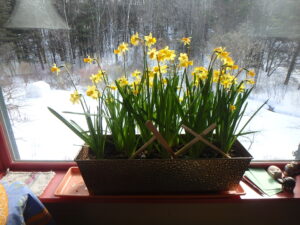
Forced tete-a-tete daffodils
Of course, the best color in the house for me right now are my forced daffodils. Last fall I potted up plenty of “tete-a-tete” daffodils and kept them in my cold cellar until recently. Each bulb provided many blossoms and even now, after the flowers have gone by, they are still pleasant looking with green leaves and dried yellow flowers.










